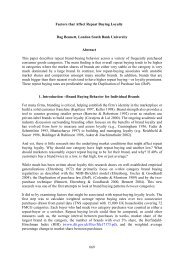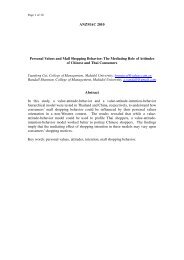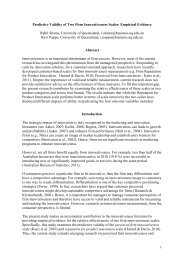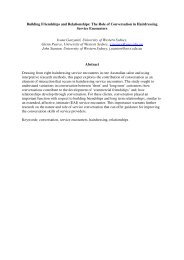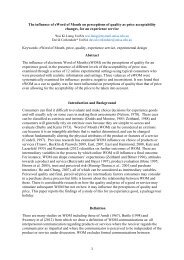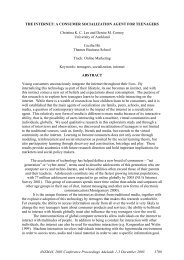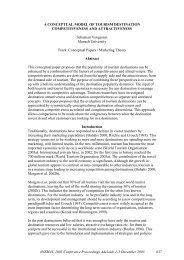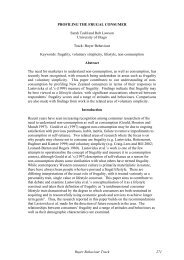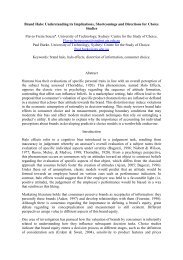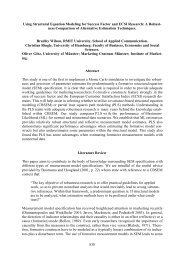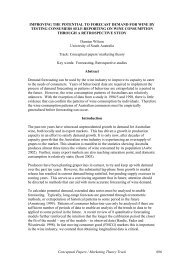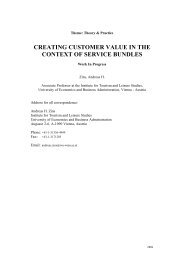Interviewing Young Children: a New Interactive Method - ANZMAC
Interviewing Young Children: a New Interactive Method - ANZMAC
Interviewing Young Children: a New Interactive Method - ANZMAC
You also want an ePaper? Increase the reach of your titles
YUMPU automatically turns print PDFs into web optimized ePapers that Google loves.
<strong>Interviewing</strong> <strong>Young</strong> <strong>Children</strong>: a <strong>New</strong> <strong>Interactive</strong> <strong>Method</strong><br />
Eliane Karsaklian, Negocia Business School<br />
Abstract<br />
In this paper, we discuss the use of specific interactive methods for researching young<br />
children. We are persuaded that using research methods closer to the children environment<br />
can allow researchers to obtain more accurate information from young targets. We therefore<br />
developed a software package that allows children from 3 to 8 years old to autonomously<br />
participate in interviews. This exploratory stage demonstrated that this method is appropriate<br />
as children were able to be interviewed without any adult help. This method can be used in a<br />
variety of marketing objectives as brand recognition, logo and packaging design, etc.<br />
Key words: Interaction, autonomy, screen, scenarios, games, play<br />
Track 10: Marketing Research and Research <strong>Method</strong>ologies<br />
<strong>Interviewing</strong> <strong>Young</strong> <strong>Children</strong>: a <strong>New</strong> <strong>Interactive</strong> <strong>Method</strong><br />
In this paper, we discuss the use of specific interactive methods for researching young<br />
children. Indeed, recent research have criticised studies that outline adult conceptions of<br />
childhood (James and al, 1998), which do not enable children to bring rich contribution when<br />
interviewed. We are persuaded that using research methods closer to the children<br />
environment can allow researchers to obtain more accurate information from young targets.<br />
We first present a general overview of the literature concerning methodological issues in<br />
collecting data with children. Then we focus on the interactive method applied in this<br />
research and its results.<br />
Literature Review<br />
The term adult box used by Roedder (1999) stresses the entire problem concerning adults<br />
interviewing children. It is a matter of methodological appropriateness. We often say that it is<br />
hard to interview children because of their lack of skills and limited comprehension of what<br />
adults say. Banister and Booth (2005) recommend a child-centric method, in which children<br />
can relate their experiences through an active role in the data collection, providing children<br />
with the tools which will allow them to do so.<br />
<strong>Young</strong> children in particular are more used to express themselves by creative methods, like<br />
drawings, for example. Funny forms and colors are part of their world and they feel more at<br />
ease when interacting via methods that integrate them. This does not mean the data they can<br />
give is less rich (Mandell, 1991). Visual and colorful stimuli are part of their life and mind.<br />
That is why they feel comfortable with some media like TV and computers. Visual and audio<br />
communication being important for children, it seems easy to understand why they feel so<br />
attracted by TV and digital games. It is known that interviewing children is a hard task as<br />
they do not know the meaning of many words and their writing and reading skills are not<br />
enough developed (Karsaklian, 1997). When young children are not able to answer to a<br />
692
question like “what do you think about this brand?” Or “what imagery do you associate with<br />
brand X?”, the adult interpretation of that is that they do not know exactly what they want<br />
and do not process information easily. Nothing could be farther from the truth.<br />
The most currently method used by researchers concerning young targets is the smiling faces<br />
scales, as they attract children’s attention. By the way, in order to answer with a smile,<br />
children should first understand the question and this will require an adult’s participation. An<br />
interesting approach conducted by Wyckham and Collins-Dodd (1997), asked children to<br />
match brands with products by using cards. <strong>Young</strong> children (from 3 to 6 years old) where<br />
able to choose the images that should go together and showed that they could easily<br />
recognize brands and logos. This experience also showed that children that could not<br />
identify a brand when it was plain script, matched the cards with the real brand very easily.<br />
A defining characteristic of children now a day is that they are highly visual. When facing a<br />
questionnaire, they go directly to the questions with graphs and charts or other visuals,<br />
instead of going through each question as they did before. Based on that fact, Kuhn and<br />
Eischen (1997) recommend researchers to present children with visual-based concepts rather<br />
than verbal statements. This provides children with a framework that they can process and<br />
through which they begin to provide feedback.<br />
According to McNeal and Ji (2003), visual impact matters more with children as they are an<br />
important audience for brand marketers, because not only are they strong influencers and<br />
future purchasers. One important observation is the fact that children pay attention to what is<br />
of interest for them and exclude all the rest. Visual imagery completely dominates the<br />
children recording of memories. <strong>Children</strong> seem to recognize brands and at some visceral<br />
level, understand their purpose. The image supports an emotional relationship for the<br />
children because they are physical and psychological representations that carry a lot of<br />
emotion. The physical representation will bring a meaning to the child whereas the<br />
psychological representation will bring pleasure (Montigneaux, 2002). The more the child<br />
will identify his/herself to the image, the more he/she will appreciate it and more pleasant<br />
this relationship will be.<br />
Acuff (2000) evokes the implication in packaging, for example, children of this age won’t<br />
pay much or any attention to verbal messages. Visual detail will be far more important as<br />
their brain is likely to focus on a predominant interesting and involving stimulus, as visual<br />
one. Images are more likely to grab their attention that verbal stimuli. Finally, Kline (2003)<br />
underlines that digital games are interactive media because they represent an emancipatory<br />
improvement over traditional one-way media and passive audiences. This one is also one of<br />
the reasons for which we designed the method presented in this paper.<br />
Objectives<br />
The main goal of the present paper is to provide a contribution to the development of<br />
appropriate research methodology addressing young targets. The purpose of the research here<br />
presented was to pre-test a method that could allow children from 3 to 8 years old to<br />
autonomously participate in an interview. The chosen subject was testing children’s toy<br />
preferences in a variety of situations.<br />
693
Research Design<br />
Each child was settled in front of a computer and when starting the session he/she was first<br />
asked to create his/her own character by pointing out if he/she is a boy or a girl and then<br />
choose the colour of the skin, the hair and the eyes.<br />
The second step was presenting the five scenarios (Christmas, his/her own birthday, a friend's<br />
birthday, his/her room, a trip) used during the exercise, for them to get to know what we<br />
would talk about. This step also allowed us to make sure that during the experiment scenarios<br />
would not grab more attention then the tasks themselves and helped the children to be<br />
familiar with the exercise.<br />
The third and last step was presenting each scenario one by one and asking children to<br />
choose three toys to put in each one of them. The scenarios are in the right side of the screen<br />
while the toys are in the left side. <strong>Children</strong> should click on the chosen toys to see them<br />
appear in the scenario.<br />
The experiment took place in two different situations. The first one was in central location<br />
where they were observed by the researchers. Each child had headphones in order to only<br />
listen to their own computer. The second situation was sending the software by Internet and<br />
asking the parents to apply it.<br />
694
Sample<br />
Our sample was composed by 53 children (27 boys and 26 girls) aged 3 to 8 years old. The<br />
average time consumed by children to do the experiment was 5 minutes. While children were<br />
accomplishing their tasks, parents were asked about which of the presented toys children<br />
already had. This information allowed us to measure a possible association between the toys<br />
they would choose and those they already owned.<br />
Analysis of the Data<br />
Although our main goal was not actually to measure children’s preferences regarding toys<br />
and situations, the method outlined allowed us to observe that there is no link between the<br />
toys children already had and those they chose at the screen. They chose those they liked<br />
more independently on the fact of already owning them or not. <strong>Children</strong> choose specific toys<br />
for each specific situation and when they choose the same toys for two different situations,<br />
they do not put them in the same order of preference. There is little difference between boys<br />
and girls regarding the chosen toys, although girls had chosen more dolls and boys more cars.<br />
The most expensive toys are associated with Christmas and their own birthday and children<br />
do not choose the same toys for their own birthday and the friend's one.<br />
Concerning the method itself, which was our main goal for this research, we can say that five<br />
minutes is quick enough to have children motivated and involved. The experiment can even<br />
take longer time if there is a need to add scenarios without children getting annoyed or tired.<br />
They actually asked for more after the exercise was over. Using their own language allowed<br />
them to autonomously participate to the interviews. No adults were called to help. Moreover,<br />
using a computer screen and representing the contents by visual elements let children think<br />
about a game they were willing to play. At the beginning, we aimed to compare the results of<br />
the interactive method with those from a smiling faces scale interview, but we realized that if<br />
we wanted to analyze 12 toys in 5 scenarios, the questionnaire would be too long, mainly if<br />
we also aimed to measure the order of their preferences in each scenario. Therefore, we<br />
decided not to compare both methods and concentrate in the interactive one.<br />
Research Limitations and Implications<br />
The level of knowledge children should have concerning computer and mouse manipulation<br />
can introduce a bias in their responses. Computers are needed to carry out the research.<br />
Moreover, it is tough to measure the reliability of a computer based measurement tool, as<br />
young children, attracted by the forms and colors of some toys, could randomly click in some<br />
of them. The interactive method was used to measure children preferences of toys regarding<br />
specific situations. This same method can allow researchers to measure brand and logo<br />
recognition, pre-testing packaging, logos, brand names, characters. This can also allow<br />
children to create marketing elements by placing shapes, colors, designs, etc. Moreover,<br />
sending the software by internet allows companies and researchers to cover big samples with<br />
small costs. Finally, it is an appropriate method for cross-cultural research, as only the off<br />
voice should be adapted.<br />
695
Key References:<br />
Acuff, D., 2000. What kids buy and why, The Free Press.<br />
Banister, E.N., Booth, G.J., 2005. Exploring innovative methodologies for child-centric<br />
consumer research, Qualitative market research: An International Journal, vol.8, No 2.<br />
Brée, J., 1993. Les enfants, la consommation et le marketing, PUF.<br />
Derbaix,C., Pecheux, C., 1998. L’attitude de l’enfant envers une nouvelle marque : de la<br />
nécessité d’une phase de fixation ? Recherche et Applications en Marketing, Vol. 12n°1/97<br />
James and al., 1998. Theorizing Childhood, Polity Press, Cambridge.<br />
Karsaklian, E., 1997. Global Advertising for <strong>Children</strong> Products. Are you joking? How to be<br />
number one in the youth market, ESOMAR conference, Copenhagen.<br />
Kline, S., al., 2003. Digital Play, McGill Queen’s University Press.<br />
Kuhn, M., Eischen, W., 1997. Leveraging the aptitude and ability of eight years-old<br />
adults….and other wonders of techonology, How to be number one in the youth market,<br />
ESOMAR conference, Copenhagen.<br />
Mandel, N., 1991. The least-adult role in studying children in: Waksler, F; Studying the<br />
social worlds of children, Falmer Press.<br />
McNeal, J., Ji, M.F., 2003. <strong>Children</strong>’s visual memory of packaging, Journal of Consumer<br />
Marketing, Vol. 20, n° 5.<br />
Montigneaux, N., 2003. Les marques parlent aux enfants, Editions d’Organisation.<br />
Roedder John, D., 1999. Out of the mouths of babes: what children can tell us, s in Consumer<br />
Research, vol 24.<br />
Roper, G., 1989. Research with marketing's paradoxical subjects: children, Marketing<br />
Research.<br />
Rossiter, J.R., 1976. Visual and verbal memory in children’s product information utilization,<br />
Advances in consumer research, vol. 3.<br />
Wyckham, R., Collins-Dodd, C., 1997. Learning brands. <strong>Young</strong> children and brand<br />
recognition, How to be number one in the youth market, ESOMAR conference, Copenhagen.<br />
696



